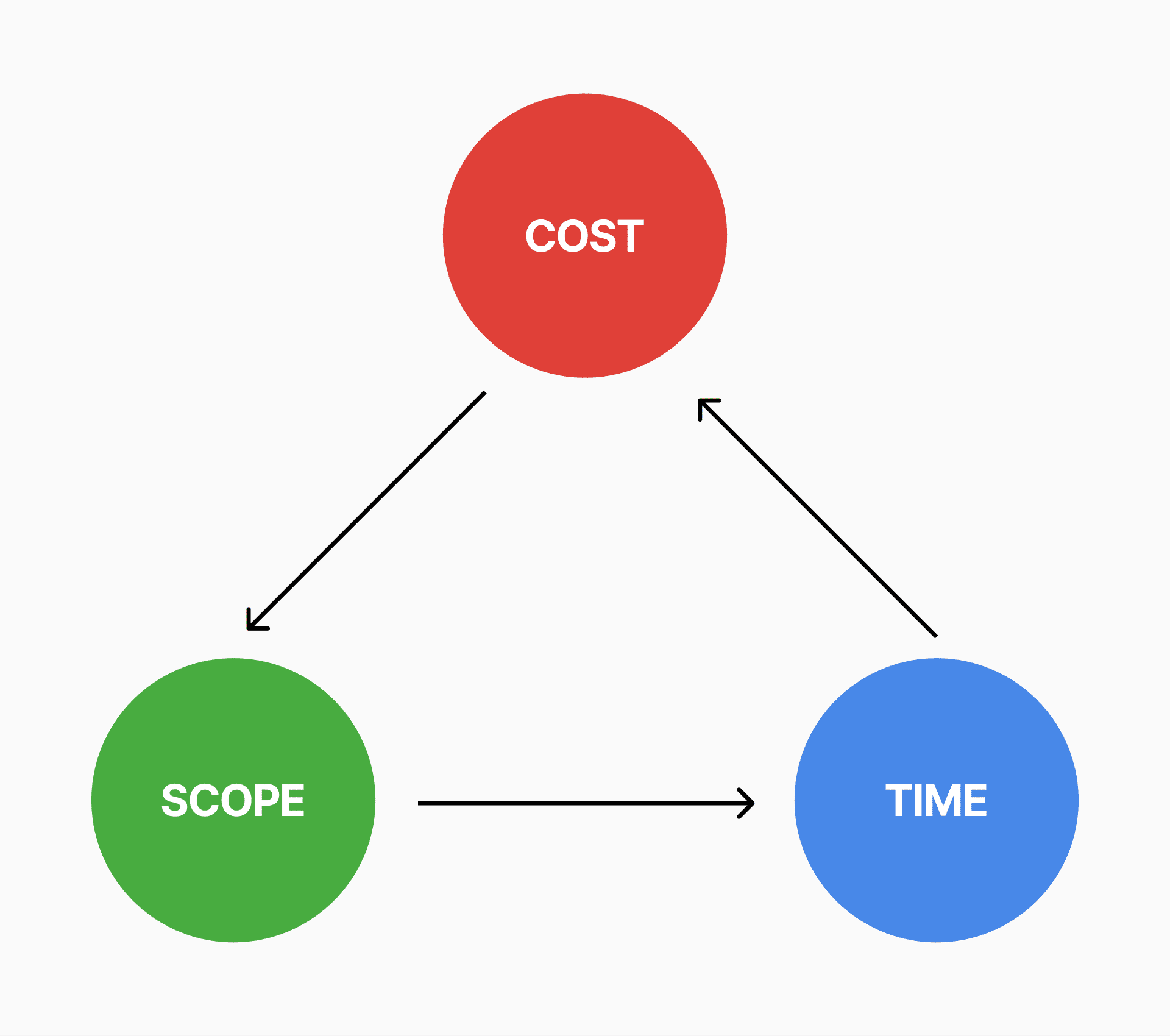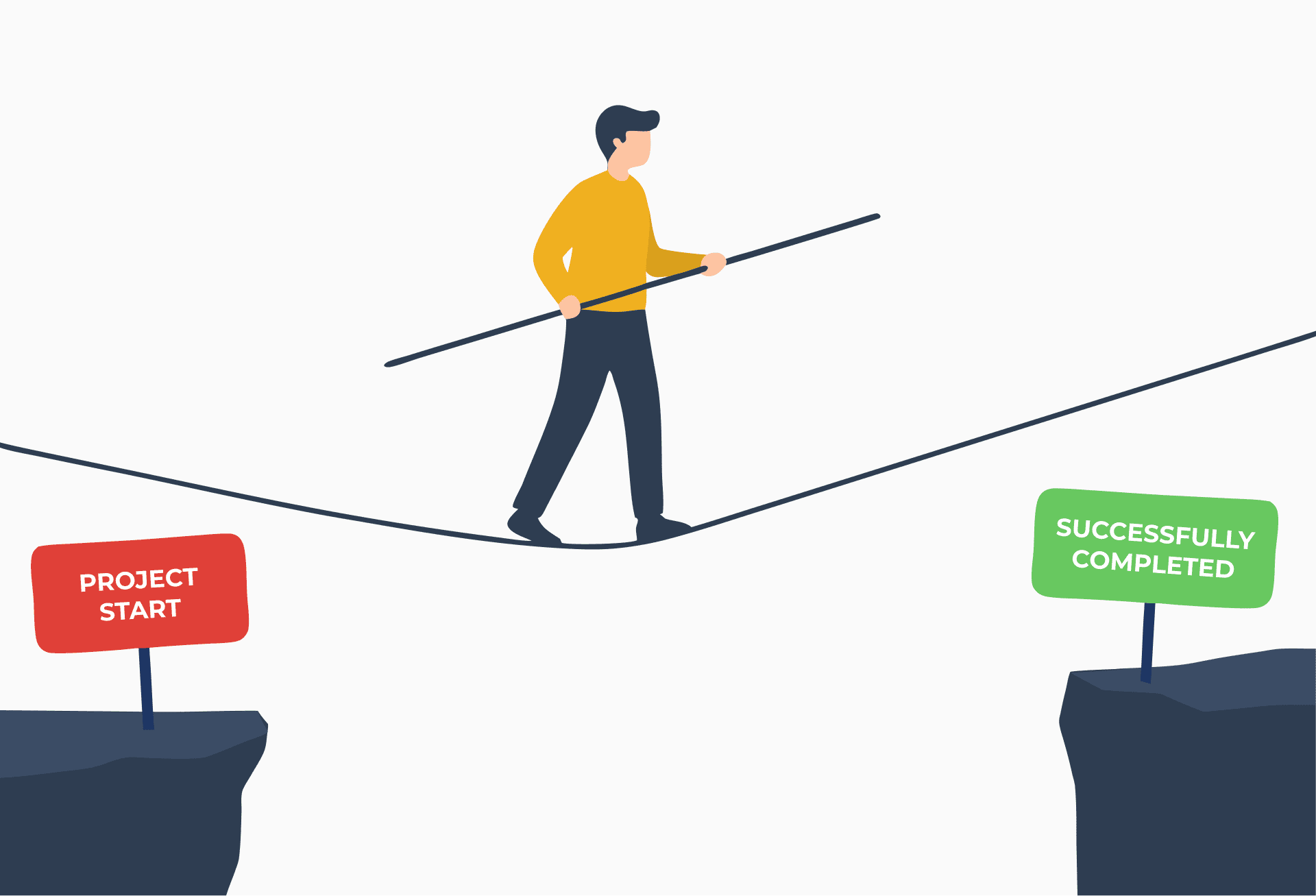The Project Management Triangle: How to Balance Time, Budget, and Quality
In 1969, NASA canceled the Mariner 8 mission due to budget overruns and delays—a classic failure within the “Iron Triangle” of project management. Decades have passed since then, but this triangle of constraints still determines the success or failure of projects today.
What do missed deadlines, budget blowouts, and unhappy clients have in common? Why is it risky to ignore the project triangle? And how exactly can you strike the right balance between time, cost, and quality when the stakes are high? Let’s explore.
What Is the Project Management Triangle?
The Project Management Triangle is a model that illustrates the three core constraints of any project: time, budget, and scope/quality. These three elements are tightly interconnected—changing one inevitably impacts the others.
Picture a triangle, where each corner represents one of these constraints. The project manager’s job is to maintain balance so that the triangle doesn’t collapse.
- Time: How long do you have to complete the project? Deadlines are a fact of life for every PM. Less time may mean higher costs or a reduced scope.
- Budget: How much money has been allocated? A limited budget might force you to cut features or look for cheaper alternatives.
- Scope/Quality: What needs to be delivered, and at what level of quality? A broader scope or higher quality often demands more time and resources.
This triangle is often called the Triple Constraint, and it functions as a universal law of project management: you can’t change one side without affecting at least one of the others.

Why Is the “Iron Triangle” So Important?
Let’s answer that by looking at a familiar scenario: a client wants you to build a mobile app in three months, on a tight budget, packed with features, and with flawless quality. Sound familiar? This is exactly where the triangle comes in.
It helps you explain—to both clients and your team—that you can’t have fast, cheap, and high-quality all at once. According to the Standish Group, only 31% of IT projects worldwide are completed on time and within budget. The rest run into trouble largely because this balance gets ignored.
In short, the triangle isn’t just theory—it is a real tool that helps you:
- Manage expectations: show clients what trade-offs are needed to reach their goals.
- Plan realistically: allocate resources in a way that makes the project achievable.
- Reduce risks: anticipate how changes in one area will affect the whole project.
How to Work with the Triangle: Practical Tips
Now that we’ve covered the theory, let’s get into the practical side. Below are some hands-on steps to help you maintain balance between time, budget, and quality.
Clearly Define Priorities
The first step is to understand what matters most to your client. For example:
- If time is critical (e.g. the launch is tied to a major event), you might need to increase the budget or reduce scope.
- If the budget is tight, consider which features can be postponed to a later phase.
- If quality is a top priority (e.g. for a medical software product), be prepared to invest more time and money.
Pro tip: During project kickoff, meet with stakeholders and ask directly: “What’s your top priority?” This simple question can prevent a lot of miscommunication down the line.
Communicate the Interdependence
As Oleksandra Poshtarenko, PMO at EPAM Systems, points out, one of the project manager’s key responsibilities is to clearly explain how changing one constraint affects the others. For instance, if a client wants to add a new feature (increasing the scope), make it clear that this could require more time or a bigger budget. Use simple examples—or even sketch out the triangle—to make the trade-offs more visual.
Use Planning Tools
Modern task trackers like Tracy, Jira, Trello, or Monday make project management significantly easier. According to research, 77% of high-performing projects rely on specialized project management software. These tools help you track progress, budget, and risks in real time.
Tip: Create a detailed project plan, assign tasks, and update it regularly. This will help you spot early signs of imbalance in your project triangle.
Be Flexible — but Firm
Flexibility is a must-have skill for any good PM. If the client insists on changes, assess the impact on the triangle and offer smart alternatives. For example, instead of adding a brand-new feature, you might optimize existing ones.
At the same time, don’t hesitate to push back if changes threaten the success of the project. Remember—your role is to protect the integrity of the project.
Treat Quality as Part of Scope
Quality is often seen as a separate factor, but it is tightly linked to scope. If you reduce time or budget, quality may suffer. To avoid this, define the Minimum Viable Product (MVP)—the minimum acceptable level of quality—and align expectations with your client early on.

Common Mistakes and How to Avoid Them
Even experienced professionals can struggle with the Project Management Triangle. Below are some of the most common mistakes, along with real-life examples and practical ways to fix them.
Ignoring the Constraints
Sometimes project managers say yes to unrealistic requests, hoping they will somehow make it work. For example: a client wants a website with Amazon-level features, a $3,000 budget, and a one-month deadline—and the PM nods along. The result? The team burns out, deadlines slip, and the client is frustrated.
- How to avoid it: Always assess the project through the lens of the triangle. If the expectations aren’t realistic, suggest cutting scope or increasing the timeline or budget. For example, convince the client to launch with a basic version first, then add features over the next few months.
- Pro tip: Create a quick checklist for evaluating new projects: “Is the deadline realistic? Is the budget sufficient? Is the expected quality achievable?”
Poor Communication
Sometimes the team or client doesn’t fully understand how one change affects everything else. For instance, a client requests a new feature, but the PM fails to explain that it will push the timeline. This can lead to misunderstandings, missed goals, and broken trust.
- How to avoid it: Keep your stakeholder list updated and hold weekly check-ins to share progress and flag risks. You can also send regular status reports like: “Here’s what’s done. Here’s what could cause delays”.
- Pro tip: Use tools like Slack or email updates to stay in touch. Sometimes, one timely message can save an entire project.
Focusing on Process Over Outcome
A common trap: new PMs often get fixated on requirements rather than on delivering real value to the client. For example, a project manager might spend weeks perfecting documentation when what the client actually needs is a quick prototype. In the end, the client gets a “technically correct” product—but not one that solves their problem.
- How to avoid it: Always keep the client’s business goals front and center. If you are working with a startup, they likely need a fast launch—not flawless code. Let’s say you are managing a project for a local café. In that case, focus on getting the online menu live quickly, not building a complex admin panel—because what the client really needs is sales.
- Pro tip: In every meeting, ask: “How will this help your business?” It is a simple question that keeps everyone focused on results, not just process.
Underestimating Risks
Another common mistake: failing to account for things going wrong—a sick developer, a delayed API from a third party, and so on. Maybe you assumed automation or integration with a payment system would take three days, but it ended up taking a week due to their side. What’s the result? Missed deadlines and budget overruns.
- How to avoid it: Always build a buffer into your plan—typically 10–20% of the timeline or budget. For instance, say you’re working on a fitness app. Adding a one-week “just in case” cushion can save the project if, say, your designer calls in sick.
Pro tip: Create a simple risk log in Google Sheets: “What could go wrong? What’s our Plan B?” Also, where possible, line up backups for key roles—just in case.

The Triangle in Real Life: Let’s Look at Some Examples
To make the triangle feel more practical, let’s walk through two real-world cases where it played a critical role.
Case 1: A Website for a Small Business
You are a PM managing the development of a website for a local bakery. The client wants the site launched in 8 weeks, with a $5,000 budget, and they are asking for everything: an online store, a recipe blog, and a chatbot for orders.
Triangle analysis:
- Time: 8 weeks is a tight timeline for this scope, considering design, development, and testing.
- Budget: $5,000 doesn’t leave room for hiring extra developers or purchasing premium plugins.
- Scope/Quality: Quality is crucial—the website represents the brand, and poor UX can turn customers away.
The problem: Based on your estimates, full functionality would take 12 weeks or $7,500. So, what’s the move?
The solution: You schedule a meeting with the client and sketch out the triangle: “If we need to stick to 8 weeks and $5,000, we will have to reduce the scope. Let’s launch with the core—an online store and blog—and add the chatbot in phase two, in a couple of months”. You explain that the chatbot would add 3 weeks or $2,000 to the project. You use a simple analogy: “It’s like baking a birthday cake: first, we make the base—the sponge—and add the decoration later”.
The result: The client agrees to launch with an MVP. The website goes live on time, the bakery starts taking online orders, and the chatbot is added in phase two once revenue is flowing. The team is happy, the client is thrilled—the triangle is intact.
Case 2: A Mobile App for a Startup
You’re managing the development of a fitness app for a startup. The client wants a 3-month timeline, a $10,000 budget, and three key features: a workout tracker, Apple Health integration, and personalized recommendations.
Triangle analysis:
- Time: 3 months is realistic for basic functionality, but not for all requested features.
- Budget: $10,000 covers two developers and one designer—but not complex recommendation algorithms.
- Scope/Quality: High UX quality is important due to strong competition in the fitness space.
The problem: The recommendation engine would require advanced AI, which adds 2 more months or an extra $5,000. Still, the client insists on having it all.
The solution: You propose a compromise: launch the app with the tracker and Apple Health integration, and instead of full-on AI, offer a filter to sort workouts by type. At your meeting, you show a Jira timeline: “Here’s how the recommendation engine would delay your launch”. You suggest adding AI in version 2.0 after they secure more funding. You use another analogy: “Imagine opening a coffee shop—you start with espresso on the menu, and introduce signature drinks later”.
The result: The app launches on time, gets great feedback for its clean and simple UX, and the startup later raises $50,000 in funding to build out more features. Once again—the triangle wins.

Bottom Line: The PM Triangle—How to Stay on Course
The Project Management Triangle isn’t just a theoretical model or a dry framework from a textbook. It is more like a daily compass in the world of deadlines, budgets, and shifting requirements. It reminds us that perfect projects don’t exist—but striking the right balance between time, cost, and quality can make them successful.
Think of it like flying a hot air balloon: if you shift one sandbag, the others need to adjust too—otherwise, you lose balance. That’s exactly how the triangle works: everything is connected.
So the next time a client asks you to deliver everything, right now, remember the triangle. Set clear priorities, explain the trade-offs, use the right tools, and don’t be afraid to suggest compromises.
And most importantly: a great project manager isn’t the one who promises the impossible—it is the one who calmly and confidently delivers results, with a clear mind and a steady hand.
 Bohdana Nosenok
Bohdana Nosenok